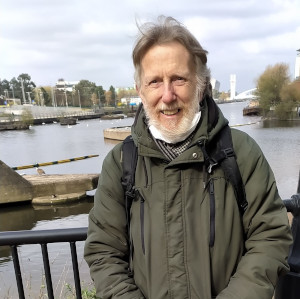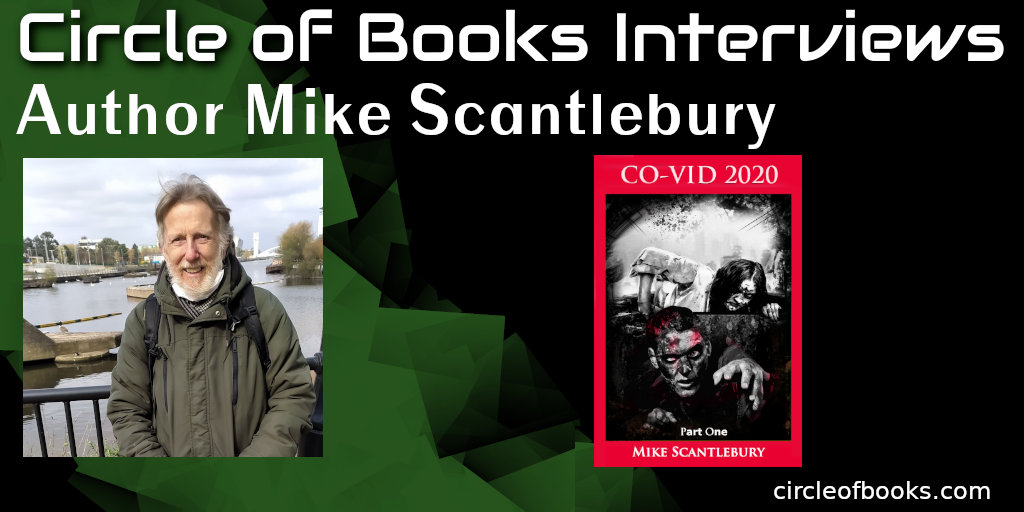Interview – Mike Scantlebury.


Interview
– When did you start writing?
It often seems to me that I’ve always been writing, but I’d be hard pressed to produce the evidence – most of it is gone. Why, even in Primary School, I was scribbling Fairy Stories. When I became a teenager, I joined a group of friends that were writing poetry. We took it in turns to copy our efforts into a large hard-backed notebook, and pass it around. I doubt much of that material would pass muster today, in these more troubled times.
Later, we started writing songs and I went through several music groups, before striking out on my own, just me and a guitar, going around Folk clubs with my little songs. (Some of these are on SoundCloud now.) Then I wrote short stories and sent them off to magazines, before committing to a full-length work. Strangely, that one, my first novel, was called ‘The Folksinger’. More short stories followed, mostly Science Fiction. One even made it onto BBC’s Radio 4.
– What moved you to start writing crime novels?
Newspapers! In a word. The awful tabloid press that we have in Britain today. The title of my first crime mystery thriller novel was ‘Black and White’. It came from an old joke. ‘What’s black and white, and red all over?’ The answer to the riddle is ‘Newspapers’, because it’s a play on words, a pun. It’s ‘read’ not ‘red’, but, of course, most of the worst newspapers in the UK are red – red tops, their titles in red print. That’s how they’re easy to spot – and avoid. Unless you want your prejudice pre-digested of course, including an unhealthy helping of misleading and inaccurate reporting, or, as we’d call it these days, fake news.
– Tell us about your new book. Why should everyone buy it? What makes it special?
For me, it’s a complete departure. I’ve been sitting down and writing ‘standard’ novels for a decade – regular characters, normal mysteries, in a recognisable format and with a rational conclusion. Then someone told me recently that readers preferred short chapters – and short books. I was planning a new 75,000 word adventure. What should I do?
Then I realised that my chapters have all been recently written in parts, anyway. I was using what I called the ‘Doctor Who’ structure. Dr Who lands his Tardis on the planet, then climbs out and heads off. His companions go another way. The great advantage of that – for the purposes of a nail-biting adventure – is that you can keep cutting backwards and forwards between the two locales, progressing the story in each, backwards and forwards. Looking at my chapters, I was delivering a six thousand word chapter with maybe three parts. That gave me an answer! All I needed to do was make each section into its own chapter. Instead of 10 chapters with three parts each – just write 30 chapters. Wow, I’ve done it – got small chapters. Simples.
But how to make a shorter book? Well, 75k cut in two is around 38,000 words, and I’d already written some of them. The Amelia Hartliss Mysteries ‘People Say Stuff’ and ‘Everybody Lies’ are two halves of the same book, published one after the other. Plus the fact that every year, in November, I take part in National Novel Writing Month. The target is to write a 50k novel purely in that month, starting 1st November and ending on the 30th. I’ve been doing that thing since 2012, and it’s part of my annual routine.
50k? 75? Why, all I had to do (I realised) is to split (what I’d call) a ‘full’ novel (75k) into 3 parts, and that would give me a target of 25k. If I wrote three parts it would make a ‘full’ book of 75k, but if the three parts could be created as ‘stand-alone’ novels, then the competed group would be a Trilogy, wouldn’t it? Even better, with short chapters, of say, two thousand words each, I would know that I had to aim for twelve chapters in order to make the target of 25k.
Yeah, yeah, it all sounds a little mechanical, doesn’t it? Maybe it would be the sort of project a robot would love – or a trained monkey – but I love a structure, and having definite targets (just like National Novel Writing Month). My crime fiction adventures are all about plot, and I like to really think them through before I start getting it down on paper. All these numbers didn’t phase me. It just became part of the planning process.
– Tell us about your hobbies and passions other than writing.
I’m not a difficult person to understand. In fact, you might say you’d be able to read me like a book! My passions creep into my novels all the time. I actually prefer that. I’ve said I like to plan my books, but I also like them to work on several levels. So, there’s the ‘running around’, the car chases and people pulling guns on each other, but standing back for a moment, I like to make sure that every book has a theme, something important.
The latest book, ‘Co-Vid2020’ is about Greed. That’s a little bit mediated by the positive aspects of Family Loyalty, but since the story is all about hunting for a lost Treasure, it’s obvious that venality is going to come out first. On top of that, one of my other passions is making short drama films, and this is a key part of the plot. The characters are convinced that the key to the location of the lost loot is contained somewhere in the interview films that Jan Branch made in 2013, and that gives me a reason to rattle on about what I know about home-made videos.
– A final message for our circleofbooks.com readers.
!Yes, please. I’d like to urge all your readers to do their darnedest to NOT become Cover Lovers!
As an emerging author, coming to notice over the last few years, I find that one of my biggest problems has been that readers have been historically reluctant to give my books a try. When I enquire, they say they see my books, but aren’t inspired by my dim and confusing covers. They like bright covers, with all the colours, and exciting looking characters.
Please! There is no connection between the text inside and the drawing on the front. In fact, it must be obvious that writers in the past who published through Traditional Publishers had no control at all over the cover preparation. It was all done for them!
People like me, self-published independent authors, have total control, (as we do with the words inside the book), but most of us are creative writers, not artists. We want praise for the story, the words – not the artwork.
Please, readers and potential readers, don’t be misled by the gaudy or self-serving illustration on the cover – read the WORDS, and give the author a fair try.
Thank you Mike Scantlebury. We at circleofbooks.com wish you much success!
Click here to visit the author page here on Circle of Books.
Tweet
